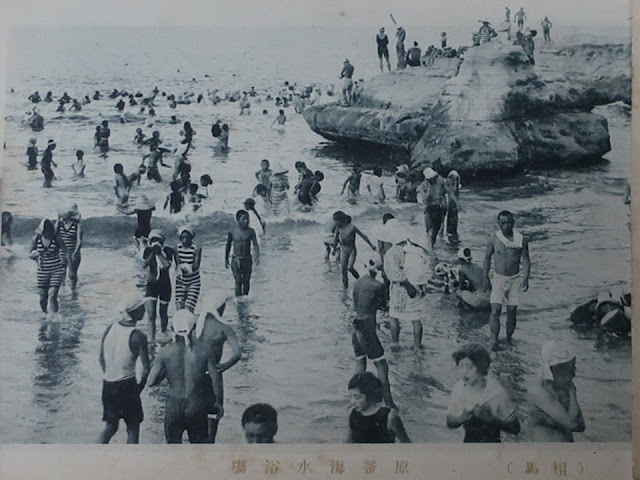Ten-ei village is located in around 200km
north of Tokyo, and it has a rich natural environment.
The museum shows us the history and the
tradition of Ten-ei well. The exhibition room is as large as three classrooms.
Old picture postcards interest me.
天栄村は、福島県中通りの南部にある、自然タップリの村です。
伝承館では、古代から現代まで、村の歴史と民俗を丁寧に展示・説明しています。展示スペースは教室三つぐらいだったでしょうか。昔の絵はがきが印象に残りました。
It is written that Ten-ei is a village of forest, lake and hot-spring. It’s an inland village.
天栄村は、「森と湖といで湯のさと」です。いいですね。
Old picture postcards、昔の絵はがき
When a camera was very expensive and a smartphone wasn’t invented yet of course, people bought postcards probably to talk about their experiences of the trips. Not only sceneries but also swimming at beach and sports day are printed on them. The exhibits were printed from the 1910s to the 1930s. We can understand their lives easily. Btw, cards are disappearing from souvenir shops.
スマホがない、どころか、カメラが高級品だった時代、旅行に行くと絵はがきを買ったのですね。町並みだけでなく、海水浴や運動会も絵はがきになっています。1910年代から1930年代のものです。当時の暮らしが良く分かります。絵はがきは、今では見かけなくなりました。
The town along the highway would be Murakami in Niigata. The view maybe same as it in the Edo period (1603~1868, pre-modern period) except for utility poles.
たぶん新潟の村上町。街道沿いの町です。電柱を除いて、江戸時代も同じ眺めだったと思います。
It is a morning market in Niigata. Some people wear old style hats (sugegasa) or towels.
新潟の朝市。菅笠をかぶった人やほっかぶりをした人がいますね。
At the Pacific Ocean coast “Souma”, horizontal strive swim suits are popular among women.
相馬の原釜海水浴場。女性のあいだでは、横縞の水着が流行っていたのですね。
A modest woman is writing something with Indian ink.
素敵な女性です。短冊に書いています。
It is written “well-known dance in Sendai (biggest city in the region)”.
「仙台名物踊り 五色布さらし」とあります。仙台に対橋楼という料亭がありますが、そこの絵はがきでしょうか。
Even the revel of drunken students in the dormitory became the theme of the postcard. I'm not sure it was rare in farming villages.
ストーム=酔っ払った学生のどんちゃん騒ぎも絵はがきになっています。農村では珍しかったのかな。
Exhibits about history and culture、歴史と文化の展示
Ancient period、原始・古代
The seal of the powerful man in around the 9th century is exhibited. It was found while farming; it’s great that the farmer found such a small object in the ground. It was designated as a prefectural important asset. The power of the dynasty in Kyoto expanded to the mountain village.
9世紀頃の豪族の私印が展示されています。畑仕事の時に発見したそうです。よくぞ、小さな印鑑に気づきました。県重要文化財です。9世紀ともなると大和朝廷の力が山間部まで及んでいました。
Medieval period、中世
There were thirty-two forts or residences of samurai in Ten-ei village. Half of them became forests, and other sites became fields or resident area.
天栄村には32もの城館跡があります。今は半分が山林に戻り、あとは田畑や宅地になっています。
The Edo period (1603~1868)、近世
Ten-ei village was ruled by Shirakawa-han. Ceramics in front are Gotou-ware which revived recently.
天栄村は白河藩の支配下でした。手前は一時は途絶えた後藤焼です。
The photo above is Maki-no-uchi post town in the early 20th century. It was a sole post town in Ten-ei. It’s lively.
会津若松と白河を結ぶ会津街道(白河街道)の牧之内宿は村唯一の宿場町でした。賑わっていますね。
Travel diary is exhibited. People who like writing have existed everywhere in Japan after the Edo period when basic education spread among people. Their records bring us pleasure of reading.
道中日記が展示されています。記録好きの人は、何時でも何処でもいますね。残していただいた記録は、我々の楽しみになっています。
Modern period、近・現代
How do you like the girl in the photo? She guides the cow and her father cultivates the rice field. The cow might be an enormous pet for her. The woman behind them might be her mother. It’s a happy time for the family.
最初の写真「代かき」。牛を誘導する「はなどり」の仕事をする女の子の表情のいいこと。牛馬は超大型ペットでもありますね。馬鍬(まぐわ)を操作して土を柔らかく、凹凸が無いようにする「しかどり」は男の仕事です。その間にいるのは、お母さんが見えるのでしょうか。いい写真です。
On the 11th of January, the opening ceremony of the rice farming is held and people pray for good harvest. A head of a family or his son digs a little, stands a small pine tree up, and offers mochi rice cakes and so on. He is grateful to the field which gives his family the sources of livelihood.
1月11日の農の始めで、豊作を祈願します。世帯主や長男が、田を掘り起こして松を立て、餅などを供えます。生きる糧を生んでくれる田への祈りですね。
In rice planting, men brought rice seedlings, older people delivered them and younger people transplant them to paddy. (The lad wasn’t a supervisor.) It was the hardest work in rice farming.
田植えでは、若者は植え方、老人は苗取り、運搬は男達が担いました。田に苗を投げ入れる「やたら植え」から、「定板(じょういた)植え」(大正時代)、「筋植え」(昭和20年代以降)に変わっていったそうです。
この手の写真を見ると女性だけが働いていたように思ってしまいます。
While seeing the tableware, we can imagine the laughter, chatting and the merry making around here.
食の道具類が並んでいます。惹かれますね。
Tableware for the main tray (upper) and the second one (lower)
お祝いの本膳(上)と二の膳(下)。ご馳走を前にした喜びが伝わりますね。
The mobile lantern might be made by a chic person. It is written “Good evening!”.
提げ行灯、洒落た人が作ったのでしょうね。
“Oshinmei-sama” was worshipped as a god of silkworm culture. It prevented diseases and misfortunes. Moreover, it cured stiff shoulder after farming, if you tap your shoulder by it.
養蚕の神として信仰された「オシンメイ様(神明?)」。病気除け、災害除けですが、オシンメイ様で叩くと、農作業での肩こりは立ち所に良くなったそうです。
The photo above are tools of woodworkers called “Kijishi” who lived in mountains to make bowls and so on. They worshipped Prince Koretaka (844-897), and they had a privilege to cut trees and migrate freely.
木地師の道具:木地師は山に住み、木から椀などを作りました。漆が塗られると会津の漆器になります。
木地師の祖・小椋氏は、惟喬親王(844-897)を主と仰ぎ、筒井公文所か高松御所の何れかの支配下にあって、在地領主の支配には属さず山林伐採の特権を与えられていました。良材を求めて移住する山の民でした。
Recent specialties of Ten-ei village are introduced such as sake (alcohol).
今の天栄村の製品が紹介されています。
There is a roadside station (shopping and resting area) under the museum.
資料館の下には、道の駅「季の里天栄」があります。
It was a fresh soba buckwheat season, so I had a hot soba noodle with tempura. Good!
新蕎麦の季節。寒かったので、温かい天ぷら蕎麦をいただきました。美味しかった。
Visited in November, 2020
Official website: https://www.vill.tenei.fukushima.jp/site/shisetsu/shisetsu-06.html
(in Japanese), accessed in August, 2021
Previous post (museum in the neighboring city):
Sukagawa history and folklore museum、須賀川市歴史民俗資料館
Next post (very
attractive and large museum in the same prefecture):
MAHORON(Fukushima Cultural Property Centre, Shirakawa Branch)、まほろん(福島県文化財センター・白河館)



























Comments
Post a Comment